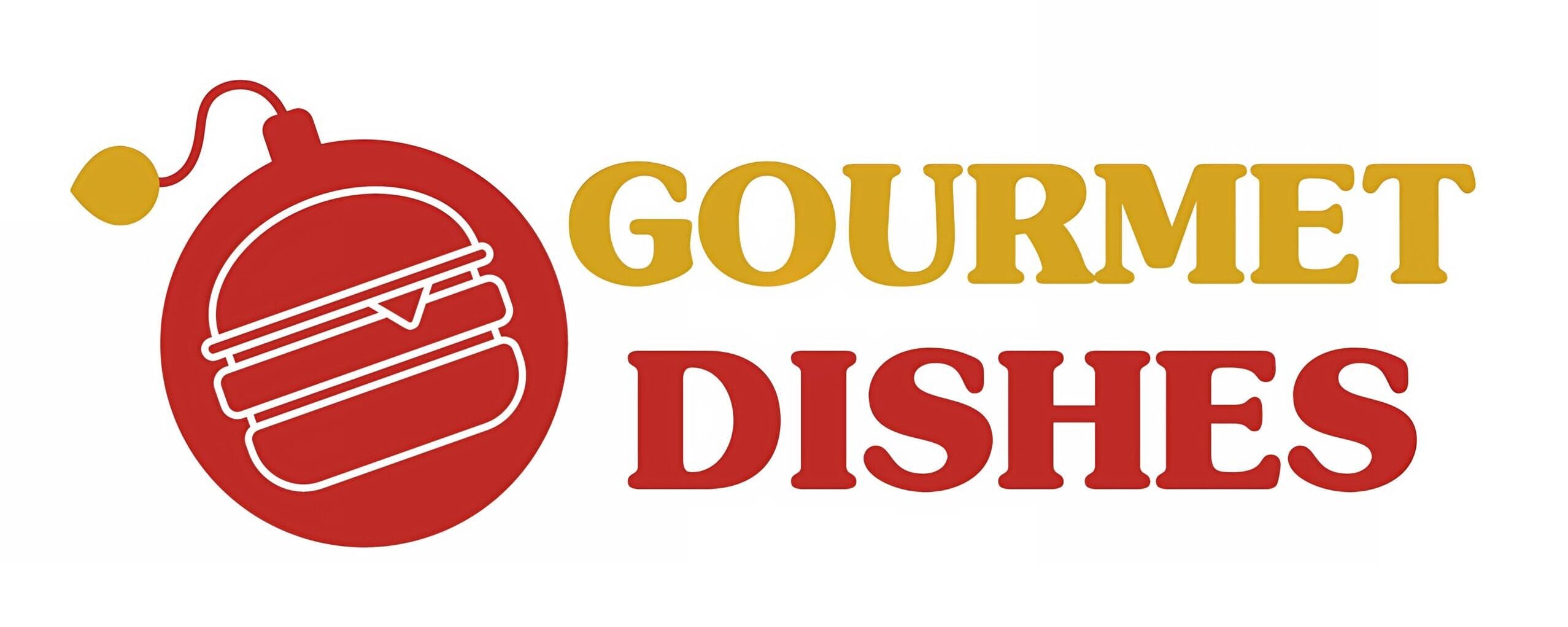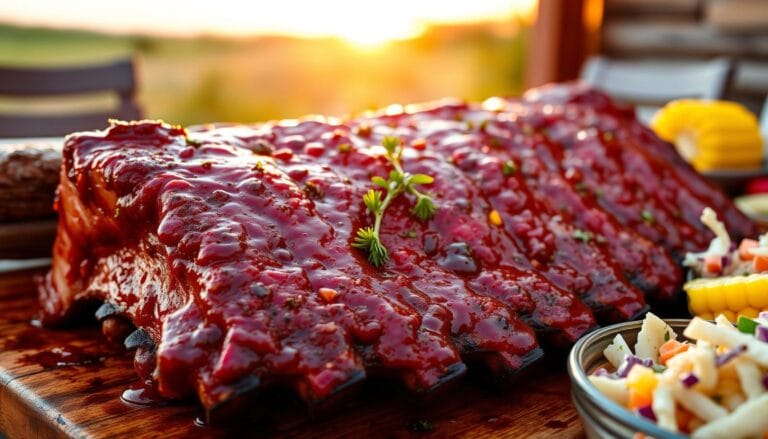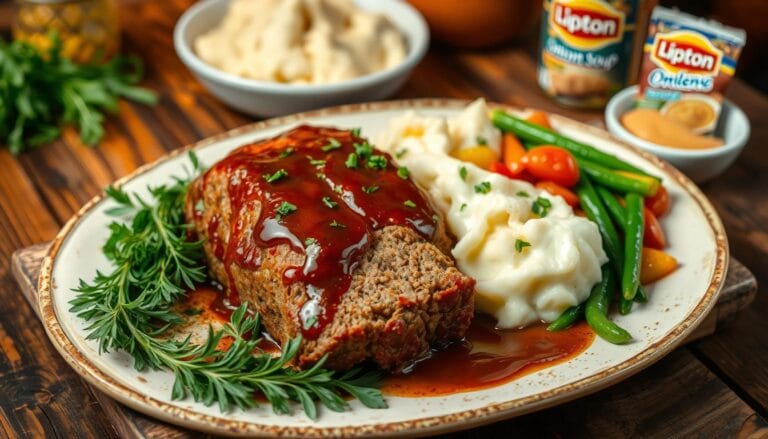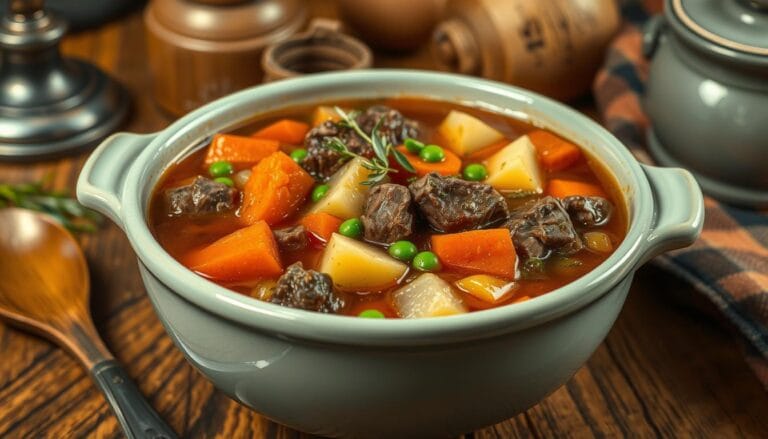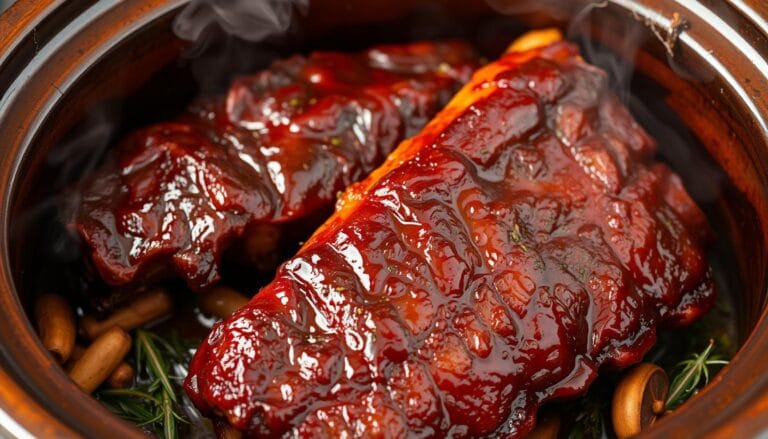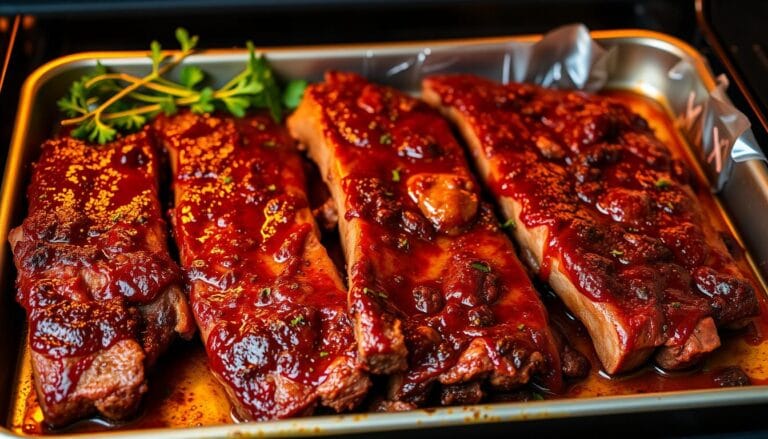Delicious Carne en Su Jugo Recipe for Your Next Meal
Every family has a special recipe that brings everyone together. For many Mexican families, carne en su jugo is that dish. The first time I tried this Mexican beef soup, I felt like I was in Jalisco’s kitchens.
This traditional recipe is more than a meal. It’s a journey through Mexican cuisine. Imagine tender beef in a savory broth, with crisp bacon and warm beans. It’s a comfort food that touches your soul.
Whether you’re an experienced cook or new to Mexican recipes, this dish will be a favorite. It will turn your kitchen into a celebration of flavors and traditions.
Key Takeaways
- Carne en su jugo is a traditional Mexican beef soup from Jalisco
- The dish combines tender beef with a rich, flavorful broth
- Perfect for family gatherings and comfort food lovers
- Relatively simple to prepare with authentic ingredients
- Offers a genuine taste of Mexican culinary heritage
What is Carne en Su Jugo: A Traditional Mexican Delicacy
Explore the rich world of carne en su jugo, a favorite dish from Jalisco, Mexico. It’s more than a meal; it’s a journey through Mexican food heritage. This dish brings the flavors of Jalisco to your plate.
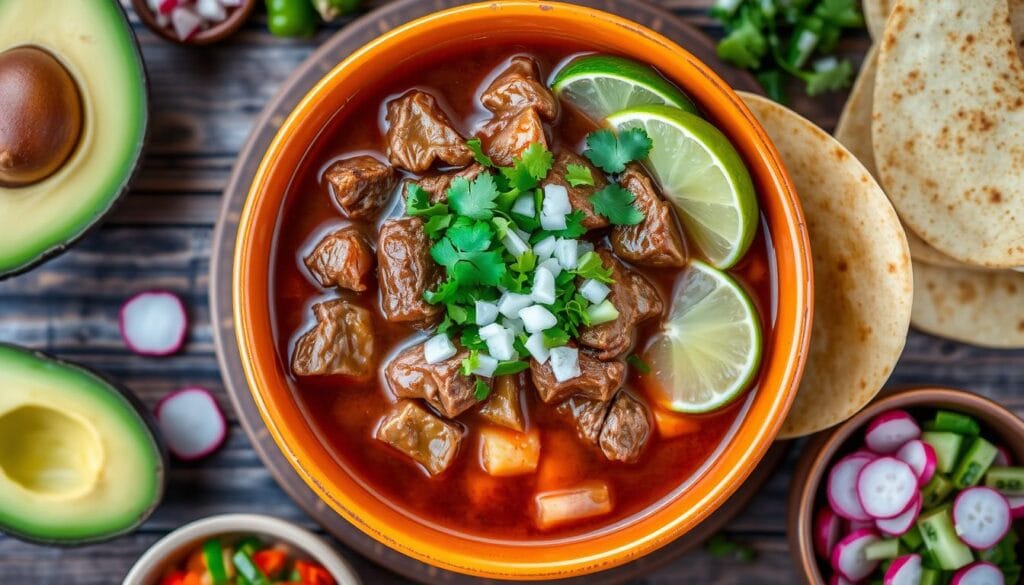
Origins from Jalisco, Mexico
Carne en su jugo comes from Guadalajara, Jalisco’s heart. It started with ranchers who turned simple ingredients into a feast. They made it for a hearty lunch to keep workers going all day.
Cultural Significance and Popularity
This dish is a symbol of Jalisco’s culinary spirit. It’s loved across Mexico for its:
- Rich, deep flavor
- Simple yet elegant preparation
- Ability to unite families
Traditional Serving Methods
Carne en su jugo is best with:
- Warm corn tortillas
- Fresh cilantro
- Diced onions
- Lime wedges
“A true taste of Jalisco in every bite” – Mexican Food Enthusiasts
Enjoying this dish is more than eating. It’s a taste of Mexican tradition passed down through generations.
Essential Ingredients for Authentic Carne en Su Jugo
To make a real carne en su jugo, you need the right ingredients. These ingredients make the dish taste like it’s from Mexico. Knowing what to use is important if you want to make it at home.
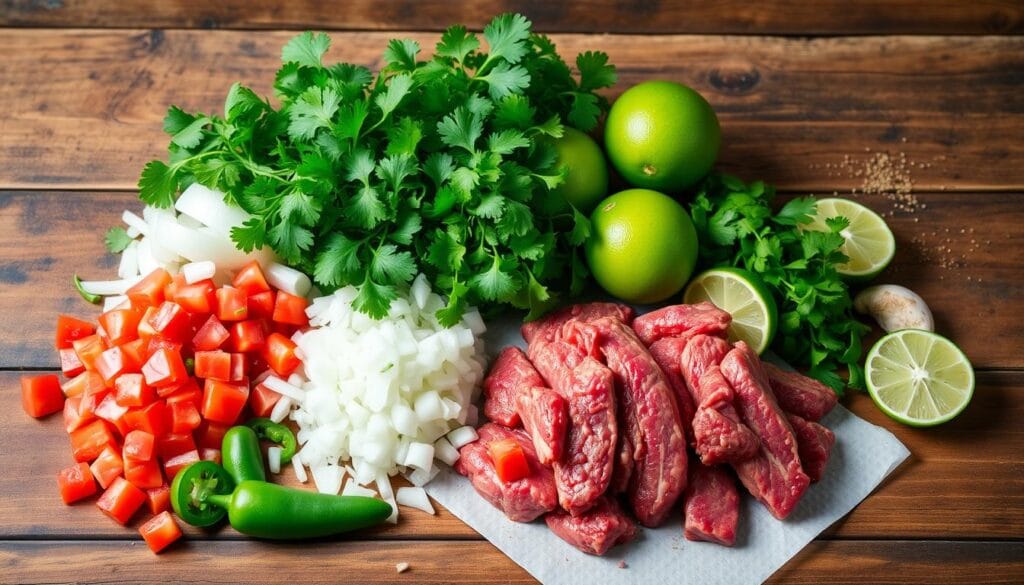
The main ingredients for carne en su jugo are a mix of proteins and fresh foods. Here’s what you need:
- Beef: Thinly sliced beef, preferably sirloin or flank steak
- Bacon: Adds depth and smoky flavor to the dish
- Beans: Traditionally pinto beans
- Fresh herbs and spices
“The magic of carne en su jugo lies in its simple yet powerful ingredient combination” – Jalisco Culinary Traditions
Choosing the right meat is key to making the dish taste authentic. Pick tender cuts that soak up the broth’s flavors well.
| Ingredient | Purpose | Recommended Quantity |
|---|---|---|
| Beef | Primary protein | 1 lb, thinly sliced |
| Bacon | Flavor enhancement | 4-5 slices, chopped |
| Pinto Beans | Texture and substance | 1 cup, cooked |
| Onions | Aromatic base | 1 medium, diced |
| Garlic | Flavor depth | 2-3 cloves, minced |
Using fresh ingredients is crucial for a true Mexican taste. Look for high-quality, local items to make your carne en su jugo even better.
Kitchen Tools and Equipment You’ll Need
To make a real carne en su jugo, you need the right tools. Whether you’re a pro chef or a home cook, the right cookware is key. It makes a big difference in making this tasty Jalisco-style dish.
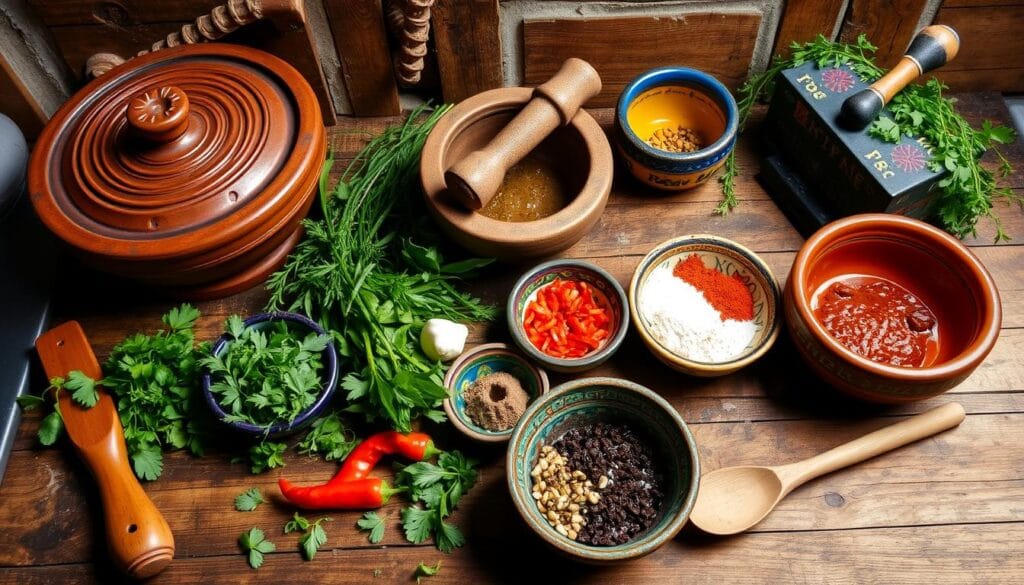
Before you begin cooking, let’s look at the essential tools. They will help you make a delicious meal.
Traditional Cookware Options
Traditional Mexican kitchens use special tools passed down through generations. These tools add authentic flavor and technique to your cooking:
- Clay comal – Great for toasting ingredients
- Cast iron skillet – Best for searing meat
- Large clay pot (olla de barro) – Traditional slow-cooking vessel
- Molcajete – Traditional stone mortar for grinding spices
Modern Kitchen Alternatives
If you don’t have traditional tools, don’t worry. Modern kitchen equipment works well too for making carne en su jugo:
- Non-stick heavy-bottom pot
- Electric slow cooker
- High-quality stainless steel skillet
- Food processor for chopping ingredients
Preparation Tools Checklist
To make cooking easier, get these essential tools:
- Sharp chef’s knife
- Cutting board
- Measuring cups and spoons
- Wooden spoon
- Ladle
“The right tools transform cooking from a chore to an art.” – Mexican Culinary Tradition
Choosing the right cookware is crucial. It helps you make a meal that truly captures the essence of Mexican cuisine.
Selecting the Perfect Cut of Meat
Choosing the right beef cuts for Mexican soup is key to a delicious carne en su jugo. The meat you pick will greatly affect the flavor and texture of your dish.
When looking for the best meat for carne en su jugo, choose tender cuts. These should be able to cook slowly without losing flavor. Mexican chefs often pick specific cuts to make this soup special.
- Arrachera (Skirt Steak): Provides rich flavor and tenderness
- Sirloin: Lean and flavorful option with minimal fat
- Flank Steak: Robust beef flavor that absorbs marinades well
- Brisket: Adds depth and richness to the broth
| Beef Cut | Flavor Profile | Recommended Cooking Method |
|---|---|---|
| Arrachera | Intense, beefy | Thinly sliced, quick sear |
| Sirloin | Mild, tender | Slow simmer |
| Flank Steak | Strong, meaty | Marinate before cooking |
| Brisket | Rich, fatty | Extended slow cooking |
Pro tip: Look for well-marbled meat with some fat content to ensure maximum flavor and tenderness in your carne en su jugo.
“The secret to an extraordinary Mexican soup lies in selecting the right cut of beef.” – Traditional Mexican Chef
When buying meat, ask your local butcher for advice. They can guide you to the perfect cut for your cooking style and taste preferences. This will give you a true carne en su jugo experience.
Step-by-Step Preparation Guide
Making a real carne en su jugo recipe needs careful steps. This guide will show you how to make a delicious Mexican dish. It’s a traditional dish from Jalisco.
Meat Preparation Techniques
Choosing and preparing the right meat is key for a great carne en su jugo. Here are the important steps:
- Choose thin slices of beef (preferably sirloin or flank steak)
- Trim any excess fat from the meat
- Cut the beef into bite-sized strips approximately 1/4 inch thick
- Season with salt and pepper to enhance natural flavors
Creating the Signature Broth
The broth is the heart of carne en su jugo. A perfect broth needs the right ingredients and cooking method:
- Blend tomatillos, jalapeños, and garlic
- Sauté the blended mixture in a heavy-bottomed pot
- Add beef broth and simmer gently
- Season with cumin and oregano for authentic flavor
Cooking Time and Temperature
Getting the cooking time and temperature right is key for carnes en su jugo:
| Cooking Stage | Temperature | Duration |
|---|---|---|
| Meat Searing | High Heat (400°F) | 2-3 minutes |
| Broth Simmering | Low Heat (180-200°F) | 20-25 minutes |
| Final Cooking | Medium Heat (350°F) | 10 minutes |
“The secret to an amazing carne en su jugo is patience and attention to detail.” – Traditional Mexican Chef
Remember, slow cooking is important. It lets the flavors mix well, making a rich and tasty dish. It will surely impress your family and friends.
Secret Tips for the Perfect Carne en Su Jugo
Mastering carne en su jugo is more than just a recipe. It’s about using authentic Mexican cooking techniques. These can turn your dish from good to amazing. Professional chefs share their secrets to make this traditional Jalisco dish stand out.
Here are the expert tips for making your carne en su jugo truly special:
- Select high-quality, marbled beef for maximum flavor and tenderness
- Use fresh, locally sourced ingredients whenever possible
- Allow meat to rest at room temperature before cooking
- Season generously with traditional Mexican spices
“The secret is in the details. Respect the ingredients, and they will reward you with incredible flavor.” – Traditional Mexican Chef
Temperature control is key when cooking carne en su jugo. Here’s a quick guide to help you get it right:
| Cooking Stage | Recommended Temperature | Cooking Time |
|---|---|---|
| Initial Searing | High Heat (400-450°F) | 2-3 minutes per side |
| Broth Simmering | Low Heat (180-200°F) | 30-45 minutes |
Pro tip: Patience is key for authentic carne en su jugo. Slow cooking lets flavors meld and meat become tender. Don’t rush it – the wait is worth it!
- Let the meat marinate for at least 1 hour before cooking
- Use a cast-iron skillet for best results
- Skim excess fat from the broth for a cleaner flavor
By following these tips, you’ll make a dish that truly captures the heart of Mexican cuisine. Enjoy it in your own kitchen!
Traditional Garnishes and Toppings
Creating the perfect carne en su jugo is more than just the meat and broth. Traditional Mexican garnishes are key to enhancing the dish’s flavor. They also add to the sensory experience.
Essential Accompaniments
The right toppings can make your meal outstanding. Here are the must-have garnishes:
- Fresh chopped cilantro
- Diced white onions
- Lime wedges
- Warm corn tortillas
Optional Flavor Enhancers
For even more flavor, try these optional toppings:
- Salsa verde for extra heat
- Crispy bacon bits
- Sliced radishes
- Grilled green onions
“The magic of carne en su jugo lies not just in its preparation, but in the artful arrangement of its garnishes.” – Mexican Culinary Traditions
Let diners add their favorite toppings to their plates. A mix of fresh herbs, zesty citrus, and crunchy veggies makes the dish unforgettable.
Common Mistakes to Avoid
Making an authentic carne en su jugo needs skill and focus. Many home cooks face mistakes that ruin the soup’s flavor and texture. This is a traditional Mexican dish.
When cooking carne en su jugo, watch out for these common errors:
- Overcooking the meat, which makes it tough and chewy
- Choosing the wrong meat cuts that are not tender
- Ignoring the important meat marination step
- Not using the right seasoning techniques
To make the perfect Mexican soup, you need to be precise. The quality of your meat and broth is crucial for success.
“Cooking is about passion, and the details matter.” – Unknown Mexican Chef
Here are key tips for making a great Mexican soup:
- Choose high-quality, marbled beef cuts
- Marinate the meat for at least 30 minutes
- Keep an eye on the cooking temperature
- Get the spice and seasoning balance right
Knowing these mistakes helps you improve your carne en su jugo. With practice and patience, you’ll master this traditional recipe.
Storing and Reheating Guidelines
Keeping your homemade carne en su jugo tasty is key. You need to store and reheat it right. This way, you can enjoy it for days after you make it.
Best Practices for Storing Carne en Su Jugo
Here’s how to store your carne en su jugo:
- Cool the soup completely before storing
- Use airtight containers to prevent flavor loss
- Refrigerate within 2 hours of cooking
Refrigeration and Freezing Options
Here are safe ways to store your Mexican beef soup:
| Storage Method | Duration | Quality Preservation |
|---|---|---|
| Refrigerator | 3-4 days | Excellent |
| Freezer | 2-3 months | Good |
Reheating Mexican Beef Soup Perfectly
To reheat your Mexican beef soup right, follow these steps:
- Remove from refrigerator and let sit at room temperature for 10 minutes
- Use a pot on stovetop for best results
- Heat on medium-low, stirring occasionally
- Add a small amount of water if soup appears too thick
Pro tip: Avoid microwave reheating, as it can make meat tough and compromise the soup’s delicate texture.
By sticking to these tips, your carne en su jugo will stay delicious, just like the first time you made it.
Health Benefits and Nutritional Information
Carne en su jugo is more than a tasty meal. It’s packed with nutrients that boost your health. It has high-quality protein and important minerals. This makes it a great choice for a nutritious meal.
This Mexican beef soup does more than just fill your belly. It’s full of protein, which helps build and repair muscles. It also gives you essential nutrients for better health.
- Protein content: Approximately 20-25 grams per serving
- Essential minerals: Iron, zinc, and selenium
- Vitamins: B-complex vitamins including B12
This hearty soup offers many nutritional benefits. The lean beef is a good protein source. The broth has collagen that helps your joints and skin.
“A single bowl of carne en su jugo can provide nearly one-third of your daily protein requirements.” – Nutritional Research Institute
People watching their weight or looking for balanced meals will love this soup. It’s full of nutrients, proteins, veggies, and broth. It keeps you full and helps your metabolism.
| Nutrient | Amount per Serving |
|---|---|
| Protein | 22g |
| Total Fat | 8g |
| Carbohydrates | 5g |
| Calories | 210 |
If you have dietary needs, carne en su jugo can be adjusted. You can make it gluten-free or low-sodium. It still tastes great.
Variations and Modern Twists
Carne en su jugo has seen amazing changes in modern Mexican cuisine. This traditional dish has been transformed in many ways. It now offers food lovers new ways to enjoy it.
Every region has its own way of making carne en su jugo. This makes the dish even more delicious and varied.
Regional Flavor Profiles
- Jalisco: Traditional preparation with classic ingredients
- Mexico City: Urban fusion with gourmet touches
- Northern Mexico: Heartier versions with additional protein
- Coastal regions: Seafood-inspired variations
Contemporary Culinary Adaptations
Modern chefs are making carne en su jugo in new and exciting ways. They use new techniques and ingredients. This shows how versatile the dish is while keeping its roots.
| Variation Style | Key Characteristics | Unique Ingredients |
|---|---|---|
| Vegetarian Twist | Plant-based protein substitutes | Mushroom, jackfruit |
| Gourmet Fusion | High-end culinary techniques | Truffle oil, exotic spices |
| Low-Carb Option | Reduced carbohydrate content | Cauliflower rice, zucchini noodles |
Whether you love traditional food or like to try new things, there’s something for you. Modern Mexican cuisine is all about keeping traditions alive while trying new things.
“Cooking is about passion, and passion knows no boundaries.” – Unknown Chef
Try out these different versions of carne en su jugo. You might find your new favorite dish.
Table of Contents
Conclusion
Learning to make carne en su jugo brings a taste of Mexico into your home. This dish is more than food; it’s a way to connect with Jalisco’s rich food culture. With the tips from this guide, you can make a dish that will wow everyone.
At first, making carne en su jugo might seem hard. But with practice, you’ll get better and more confident. Every time you cook it, you’re keeping a tradition alive that has been loved for years.
Now, you know how to turn simple ingredients into a delicious dish. Whether it’s for a big event or a simple dinner, carne en su jugo is a hearty and tasty choice. Enjoy the process and relish every bite of your homemade dish.
